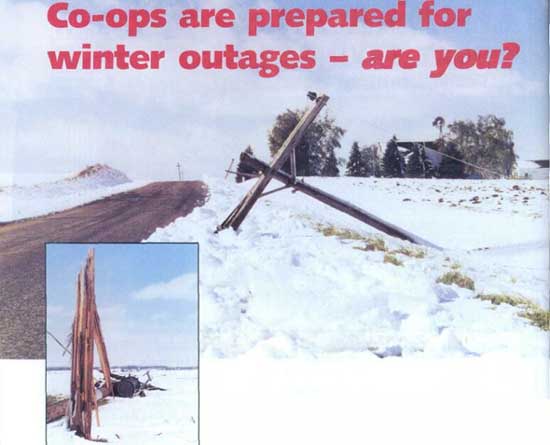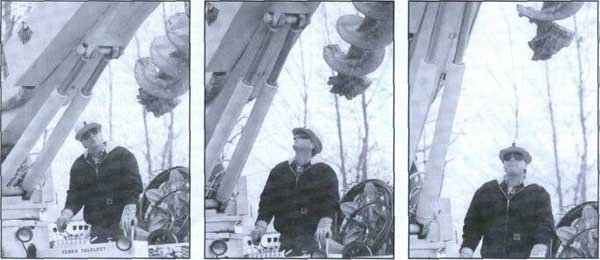 |
Home | Search | Browse | About IPO | Staff | Links |
 |
Home | Search | Browse | About IPO | Staff | Links |
|

Story by Catrina D. McCulley The New Year came in with a cold sweep this year bringing an abundance of snow and ice to many parts of Illinois. While the majority of us were left wondering how we were going to get our cars out from under the mounds of white, people in many parts of Southern Illinois were wondering when their power would be restored. Harry Kuhn's staff at Egyptian Electric Cooperative, Steeleville, took action immediately on January 2 around two a.m., when a 69,000 volt transmission line fell through pine trees onto a 12,000 volt distribution line, knocking out an entire substation. "We had to restore the transmission service to the substation first," said Bryce Cramer, district office manager. It was obvious by early morning that the storm had done more damage than the Egyptian crews could undo all by themselves. Richard McGill, manager of engineering and plant operations, called the Association of Illinois Electric Cooperatives (AIEC), the statewide service association, to seek help through the IEC Emergency Work Plan (EWP). "3:30 in the morning we called in our crews and later in the day we asked the Emergency Work Plan for additional crews," McGill explained. "But at the time we did, no help was available. Eventually, Monroe County Electric Co-Operative (Waterloo) and Southern Illinois Electric Cooperative (Dongola) were able to send crews to us." The storm not only affected Egyptian Electric Cooperative, but Tri-County Electric Cooperative, Mount Vernon, and Wayne-White Counties Electric Cooperative, Fairfield, as well. Rick Polley, AIEC manager of field services and EWP coordinator, contacted other cooperatives, including M.J.M. Electric Cooperative, Carlinville; Southwestern Electric Cooperative, Greenville; Illinois Rural Electric Cooperative, Winchester; and Monroe County Electric Co-Operative to request assistance for those co-ops in need. "The Emergency Work Plan has economic benefits," Polley said. "Cooperatives have the assurance that additional help is available when they need it the most," he added. Unfortunately, this storm hit so suddenly that it required some outside help as well. Polley clarified, "Other cooperatives also 12 ILLINOIS COUNTRY LIVING MARCH 1999
MARCH 1999 ILLINOIS COUNTRY LIVING 13
go up and down," Cramer explained. "That's what's happening to a conductor during galloping." When this occurs, the up and down motions causes the conductor to come into contact with other conductors. "The strain could break poles off," Cramer added, "but a lot of times it will just cause lights to blink." Technology to the rescue Added manpower wasn't the only ally co-ops used to win the battle against Mother Nature. Recent developments in new technology, such as electronic answering systems, have also assisted co-ops in responding to storm outages efficiently. Co-ops such as Egyptian Electric and Corn Belt Energy of Bloomington use a system called the Primary Outage Response Call Handling Equipment, or PORCHE. During the first day of Egyptian Electric's storm, the cooperative's PORCHE system handled more than 6,000 calls, Cramer noted. During an outage, members can call in and report problems by entering their phone number on a touch-tone phone. The system then looks through a customer database for a match. When a match is found, the system reads the number back to the caller for verification. If the caller has specific information about the outage that they would like to report, the system will ask you to record a voice message. The message then appears on the dispatcher's computer screen. Cramer said "The PORCHE system is able to answer more calls than we could do manually." McGill added, "It answers eight lines simultaneously and the messages are very succinct. The data we receive from the computer is in a format that is easy to integrate and process." Outage preparation Severe weather in Illinois can happen anytime, and the co-ops know this. They spend many hours during milder seasons preparing for the worst. "We've had a very aggressive pole change-out program for the past five years," said Cramer, "and we've gotten a lot of the older poles out." "These storms can show our weaknesses, but they can also show what things we are doing right," said McGill. "Re-investing in pole changes is one area that really helped us." 14 ILLINOIS COUNTRY LIVING MARCH 1999
Another way the co-ops prepare is by keeping their System Control and Automated Data Acquisition (SCADA) systems updated. SCADA is one of the new ways that electric co-ops are able to remotely monitor and control substations. They also make sure the electric system is protected by changing out and properly coordinating lightning arrestors and other protection equipment. Like a fuse in your house, this equipment can prevent damage to transformers during storms. All of the co-ops have maintenance schedules to make sure everything is in the best possible condition in case of a storm. Allan Masterson, director of member services at Monroe County Electric says, "The more maintenance we do, the better prepared we are." Outage tips from your co-ops When an outage situation occurs, it is important to know what you can do to help. For example, you should turn off all electrical equipment like your heating system, refrigerator and hot water system. This can be accomplished at the main breaker panel in your house. "If power has been off for any amount of time, we get what we call 'cold mode pick-up,"' Cramer explained. "When we first energize the line, everybody's equipment is trying to come on all at once and it overloads the breaker." Egyptian urges members to wait at least 10 minutes after power has been restored before turning anything on, and then only turn one thing on at a time with 30 to 45 minute intervals. Norris Electric Cooperative, Newton, suggests that you keep a copy of your bill nearby so if you have to call to report an outage, all of the information the dispatcher may need from you, including your account, pole, and line number, is handy. Monroe County Electric urges everyone to call in to report an outage. "Don't assume that your neighbor has called in," advises Brian Beem, superintendent of operations. If everyone assumes that someone else will call to report the outage and nobody does, members may be without power needlessly. Most importantly, all of the coops urge you to please be patient. All of the employees are working with one common goal in mind, to restore your power as fast and safely as possible.

Kent Benefiel, a lineman at Norris Electric Cooperative, works to restore service to members in southern Lawrence County after January's storm covered the area in ice and snow. MARCH 1999 ILLINOIS COUNTRY LIVING 15 |
|
|